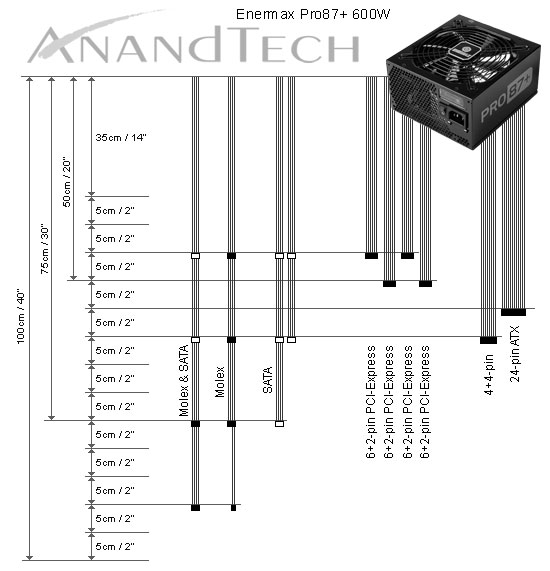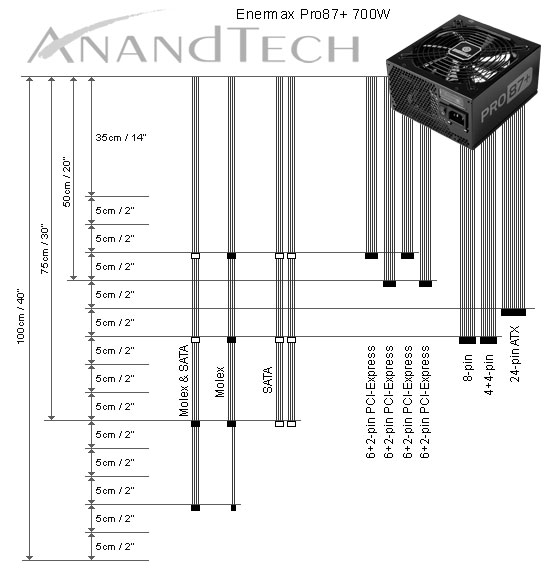Enermax Gold: Modu87+ and Pro87+
by Christoph Katzer on January 19, 2010 1:00 PM EST- Posted in
- Cases/Cooling/PSUs
Pro87+ Cables and Connectors

The cable lengths from the Pro87+ slightly differ from those on the Modu87+. We found for example shorter cables with PEG connectors. All cables are sleeved. The 500W unit has two 6+2-pin PEG connectors while both higher rated units come with four 6+2-pin PEG connectors. The length of these important cables is average ranging from 45cm (PEG) to 60cm (4+4-pin ATX12V). The main 24-pin connector has a length of 55cm. The 600W and 700W units have two different lengths for the PEG connectors, with two each of 45cm and 50cm. There are six to eight SATA connectors on these units, which is more than adequate for most setups. There are five Molex connectors on all of the units, which is also more than enough for the average user today.













59 Comments
View All Comments
0roo0roo - Monday, February 15, 2010 - link
simple, to the point, should be done more.JFrizzle - Friday, February 12, 2010 - link
Where do you get the Enermax Modu 87+ 500W? I can only find the 700W on New Egg, and can barely find the 600W flavor. Have these items been released yet? If not, when is the expected release date?cupoftea - Sunday, January 24, 2010 - link
I would be really interested to see how this compares to another PSU from Germany, the Nesteq ASM X-Zero 500 semi-passive.KoVaR - Thursday, January 21, 2010 - link
Really nice PSUs, but a bit shame they come with three 12V rails instead of one "big one"ssj3gohan - Thursday, January 21, 2010 - link
To be brutally honest here, I would be very surprised to find more than one person in the pool of hardware geeks that are my friends that has a computer that, even under load, consumes more than 300W. Even really powerful gaming machines (say, core i7 + HD5870) usually draws around about 100W idle, and with recent developments usually even less than 80W (yes, really). Under load, these machines barely top 200W. You would need to do some serious skulltrailing to build something that needs 400 or 500W.For the serious gamer, a 350W PSU should be the norm - why you ask me? At idle, a single-processor, single-gpu machine uses about 20% of the PSU's rating, and that is where the serious efficiency benefit is for forward converter topologies. Right now, gamers use ridiculous 500+ W power supplies which leaves the PSU uselessly wasting energy at idle, where the computer is most of the time anyway.
This is by the way also one of the humongous errors made by various reviewers (not anandtech by the way) - they for instance try to test a C2D E5200 (extremely power-efficient) but decide to run it in their usual test bench which inevitably contains a power supply designed for overclocking. Then they're surprised that the E5200 seems to be no more efficient than a Q9600 or something, but in reality the E5200 system consumes so little that the PSU is hopelessly inefficient at that point. If you use this knowledge you can build machines that idle below 35W by just and only using a very low-wattage power supply (barring the truly high-end video cards of course)
7Enigma - Thursday, January 21, 2010 - link
I'll agree with you to an extent. The 700+ PSU's are more than overkill for most people. But keep in mind the longevity of the PSU. Most people do not like their PSU's running 80% of capacity when under load, and I constantly hear 60% as the sweet spot for long-life. We are now approaching a sort of saturation point for PSU efficiency so I don't see people buying a new PSU every single time they upgrade or rebuild. It was different when we were jumping from 50-60-70% efficiency. But going from 80-82-84-etc is not really that big (from both a utility cost and heat standpoint).These new PSU's are great in that they get very high efficiencies at anything pretty much above 20%. Other brands are also almost there (25-30%), so it's kind of moot. You're not going to see large price differences if they made 350 or 400w because the main cost is in design and manufacturing, not so much the difference between parts (some but not the bulk of the cost).
Christoph Katzer - Thursday, January 21, 2010 - link
http://geizhals.at/deutschland/a497624.html">http://geizhals.at/deutschland/a497624.htmlCheck out the street prices, the MSRP of the Modu87+ was 150€ and it's now already at 116€...
yyrkoon - Wednesday, January 20, 2010 - link
"Enermax posted this video on YouTube to show real life experiences and how they could be solved with CordGuard. We think it's dangerous to let kids play behind a PC in the first place, and let's just hope they don't notice the power switch…."Or do one of the more creative/inventive things kids have been known to do. Like perhaps try to stuff a peanut butter and jelly sandwich through the fan grill . . .
But right, I do not think any responsible parent is going to let their young kids play around with the power supply of a computer in the first place. I would think Enermax needs to work on their marketing a bit more . . . The video stinks, and screams "skiddy". CordGuard is not a terrible idea, but come on. Are they really trying to market a $.05 gimmick ? When did the name Enermax sink so low ?
Personally, I would like to see some aircraft quality (screw-on ) connectors for the removable power connections, and a plain black fan would be perfectly fine with me. Also, I agree that the name badge on the fan guard is not necessary. Yes, I *would* pay more ( fair price ) for the above mentioned connectors.
gwolfman - Wednesday, January 20, 2010 - link
Why is 115VAC so inefficient in comparison to 230VAC?ClownPuncher - Wednesday, January 20, 2010 - link
I can see the appeal, but for me a single 12v rail over 50a is ideal, rather than 3-4 rails.